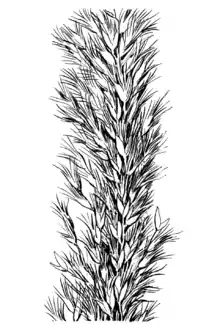Pappophorum bicolor
Pappophorum bicolor is a species of grass known by the common name pink pappusgrass.
| Pappophorum bicolor | |
|---|---|
 | |
| Pappophorum bicolor[1] | |
| Scientific classification | |
| Kingdom: | Plantae |
| Clade: | Tracheophytes |
| Clade: | Angiosperms |
| Clade: | Monocots |
| Clade: | Commelinids |
| Order: | Poales |
| Family: | Poaceae |
| Genus: | Pappophorum |
| Species: | P. bicolor |
| Binomial name | |
| Pappophorum bicolor E.Fourn. | |
Distribution
The plant is bunchgrass endemic to North America, where it occurs in Northeastern Mexico and in Texas (United States).[2] It is found in the Great Plains, other prairies, meadows, pastures, oak savannahs, and along roadsides.
Description
This perennial bunchgrass grows up to 1 m (3 ft.) tall. The leaves are up to 20 or 30 centimeters long.
The narrow panicle is somewhat pink to purple in color.[2] It blooms from April to November.
Uses
Pink pappusgrass is used for the revegetation of rangeland, seeding along roadways, and for native habitat restoration.[3] It is good for wildlife, and it provides a forage for livestock.
Cultivation
Pappophorum bicolor is cultivated as an ornamental grass, for use in traditional, native plant, and wildlife gardens.[4][5][6]
The grass may be attacked by the rice stink bug (Oebalus pugnax).[3]
References
- illustration circa 1950, probably by Agnes Chase, published in for Albert S. Hitchcock, Manual of the grasses of the United States. Ed. 2.
- Grass Manual Treatment: Pappophorum bicolor. Archived 2015-04-27 at the Wayback Machine
- Pappophorum bicolor. USDA NRCS Plant Fact Sheet.
- Lady Bird Johnson Wildflower Center Native Plant Information Network−NPIN: Pappophorum bicolor
- Pappophorum bicolor. USDA NRCS Plant Guide.
- Texas Wildscapes: Gardening for Wildlife; Damude, N. & K.C. Bender; Texas Parks and Wildlife Press; (1999) Austin, Texas; ISBN 1885696302 .
